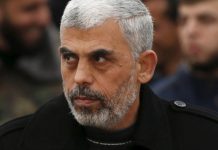
The night had started as a peaceful demonstration, with chants of “no justice, no peace,” and shouts of Breonna Taylor’s name – one of a string of deaths of unarmed African-Americans that has drawn national attention in recent weeks.
It ended in chaos, with seven people wounded by gunfire that city officials said originated in the crowd and spurred police dressed in riot gear to engage with protesters. The shooting victims were in stable or good condition Friday.
Taylor, a 26-year-old emergency medical technician, was sleeping in the middle of the night on March 13 when police entered her home to execute a no-knock drug warrant. Her boyfriend, thinking the police were armed intruders, fired a gun; police returned fire and Taylor was shot eight times. She died at the scene.
No drugs were found, according to a lawsuit filed by Taylor’s family, which accuses officers of wrongful death, excessive force and gross negligence. The FBI is investigating.
Thursday night’s protests in Louisville represented a tipping point for many in a city that residents say is not prone to widespread demonstrations of this sort – the last protest in Louisville close to Thursday’s scale were deadly race riots in 1968. But in the wake of Taylor’s death and the more recent deaths of Ahmaud Arbery in Brunswick, Georgia, and George Floyd in Minneapolis, black and white Louisvillians took to the streets Thursday.
Only three out of an estimated 600 demonstrators were arrested, but there was significant destruction downtown. Windows were broken on government buildings, garbage cans were hoisted atop cars and the right hand was torn off a statue of Louis XVI near city hall.
Protesters, exhausted by the novel coronavirus pandemic, were desperate to speak out against police brutality. Members of the city’s black community wanted to demonstrate their long-simmering distrust of local police.
“It’s like things are coming to a head, it’s almost collecting nationwide, and I think that kind of amped up Louisville protesters,” said Haven Harrington, a community organizer on the city’s west side. “Normally people in Louisville don’t protest quite like this, to this scale. All these [deaths] happened back-to-back-to-back. The country as a whole is charged.”
It was just after 2 a.m. Friday when Jasmine Harris finally returned to her apartment on the west side of Louisville, where her three children were already asleep. Her voice was hoarse. Her face burned from tear gas. Her right leg and arm bore welts from two rubber bullets that had hit her just a couple hours before, when Harris joined hundreds downtown in the protest.
Harris, a 27-year-old activist, tried to process the events of the night as she poured milk over her face and slipped into a hot bath with Epsom salt added to soothe her bruises. By the time she climbed into bed at 4 a.m., she resolved to protest again Friday night. This time, she would wear long sleeves and bring milk and water.
“This was my wake-up call,” Harris said.
Thursday’s protest took place downtown, just a few blocks east of what locals call the Ninth Street divide, the corridor that demarcates the largely African American communities in west Louisville from the largely white neighborhoods in the rest of the city.
It’s where many of the city’s hospitals and government buildings are clustered along with hotels and the University of Louisville’s basketball arena, the KFC Yum! Center, where Thursday night police engaged with protesters.
Around 10:30 p.m., gunshots rang out in the crowd and seven people were wounded. Police sprayed tear gas and rubber bullets, according to multiple witnesses.
In a news conference Friday morning, Mayor Greg Fischer said five of the shooting victims were in good condition and two others, who were sent to surgery, were in stable condition. LaVita Chavous, assistant chief of police in the Louisville Metro Police Department, said two police officers were taken to the hospital with conditions “spurred by the events.”
Fischer denounced the violence Friday but called for peaceful protests and acknowledged demonstrators’ concerns, indefinitely suspending no-knock warrants.
In the months following Taylor’s death, Fischer’s administration handed the police’s internal probe of the shooting over to Kentucky’s attorney general and sent the findings to the U.S. attorney’s office and the FBI, which has since opened its own investigation.
“These changes and more to come – we’re not done – should signal that I hear the community. . . . Breonna Taylor’s name and her story will now be part of our city’s history. But as Breonna’s family shared last night,” Fischer said, referencing a video message from Taylor’s sister, “answering violence with violence only makes things worse.”
Still, many in Louisville’s black community vowed to gather again Friday, with hopes of a more peaceful protest.
Walt Smith, a 34-year-old West Louisville resident, saw the destruction of Thursday night’s gathering when he ventured out to survey the aftermath early Friday morning. There was nobody left in the streets. He saw busted windows on the city’s correctional facility. He saw graffiti on walls and trash littered strewn across the ground.
“This is the response you get when there is no justice happening,” Smith said
Early Friday evening, dozens of protesters returned to the intersection that saw the tear gas confrontation with police.
Dino Johnson, 52, was protesting for the second night and said the reforms the city has so far made do not go far enough.
“There need to be arrests. There needs to be some justice,” he said. “When you commit a crime as a civilian, you have to face the consequences. Just because you wear a blue uniform, you still should have to face the consequences.”
(c) 2020, The Washington Post · Ava Wallace, Roman Stubbs
{Matzav.com}











